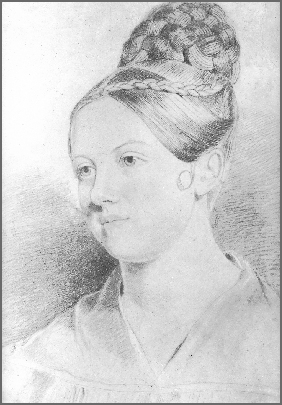
PETER LE NEVE-FOSTER II
Peter Le Neve-Foster's son Peter is, apart from the duelling Oliver Le Neve, quite the most interesting member of the family. He was born at the White House, Lenwade, in 1809, and was educated at the Norwich Grammar School under Dr. Valpy, one of its most famous headmasters. From school he proceeded to St. John's College, Cambridge, but migrated to Trinity Hall where he graduated as 38th Wrangler in January 1830. He took his Master's degree in July 1833 and was elected a Fellow of his College on 28th November 1835. After graduating in 1830 he started reading law and was called to the Bar in the Middle Temple in 1836. I have before me his diary for that year and quote the following extracts:
"29th January, Friday
Arrived in Town, breakfasted with Roberts. Papers transferred
to Temple for my call. Went to Camberwell in evening-a dinner
party.
30th January, Saturday
Went to Town early, called to the Bar this evening and
returned to Camberwell."
Later in the same year-1836-there are some
more entries of interest:
"27th March, Palm Sunday
Went to Norwich in afternoon to stay with Chase for the
Assize week.
28th March, Monday
In Court.
29th March,- Tuesday
Mounted (?) my wig and gown for 1st time on joining circuit.
Dined with the judges. Rec'd my 1st brief.
30th March, Wednesday
In court again. Dined at Chambers with my sisters.
(Note: This means a cousin named Chambers, not a barrister's
chambers.)
31st March, Thursday
In court again."
One guesses that Grace and Belle had come in from Lenwade to the Norwich Assize to hear their brother plead his first case.
This diary contains a number of entries about letters to and from Grace, but very little about Belle, from which one concludes that Grace must have been the favourite sister. At this time Lenwade Mill was let to a Mr. Dutt, but Peter evidently still had something to do with the property, as there is a diary entry about repairs to the water wheel. The mill was held on lease from the Warden and Scholars of New College, Oxford, from whom Peter also held the rectorial tithes of Great Witchingham and was bound to distribute amongst the poor of the parish ten bushels of peas annually on Ash Wednesday.

Peter's sister Grace (later Mrs John Nunes). From a pencil sketch made by Elizabeth Rigby.
Peter's diary also contains a number of entries about visits to Mrs. Chevallier at Great Yarmouth, an oblique reference to the fact that he was courting Georgiana, one of her five daughters. The Chevalliers, like the Le Neves, were a distinguished East Anglian family and could trace their descent in a direct line from Joan Plantagenet, a daughter of Edward I and Eleanor of Castile. They were also closely connected with the Kitchener family as Georgiana Chevallier, the future Mrs. Peter Le Neve-Foster, was first cousin to Frances Chevallier, the future Mrs. Kitchener and mother of Herbert Horatio Kitchener, who was to become Field Marshal Earl Kitchener, the victor of Omdurman and Secretary of State for War from 1914 until his death when the "Hampshire" struck a mine en route for Russia in 1917.
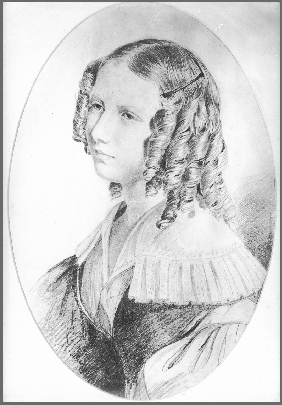
Peter's sister Belle (later Mrs Benjamin Nunes). From a pencil sketch made by Elizabeth Rigby.
Apart from his legal and mathematical interests, Peter was also on friendly terms with a number of artists including Horace Love, the famous Norwich miniaturist and Elizabeth Rigby (later Lady Eastlake), who both painted and sketched him. According to one family tradition, which may well be true, Elizabeth Rigby was Peter's first love and it was only after she had turned him down that he began to pay his attentions to Georgiana Chevallier. Whether or not this is true, it is certain that he was on friendly terms with Elizabeth some years before he began courting Georgiana, as Elizabeth did a portrait of him as early as 1834.
Love certainly stayed at Lenwade and Yarmouth, where he painted Georgiana's portrait in December 1836, perhaps as a wedding present, as Peter and Georgiana were married in Gorleston Church in 1837. There are also diary entries about dinner with J. B. Crome, the artist son of John Crome, the "Old Crome" of the Norwich School of Painting. Peter himself was a competent pencil sketcher about which l shall have more to say later.
The year 1837 was an important one for not only was it the year of his marriage, but it was also the year in which he was elected to membership of the Society of Arts, which was to prove one of the most important events in his life. His mother's family, the Osorios, had had Society of Arts connections for many years and his father had been a member. Peter himself was elected on the suggestion of his Osorio grandfather. Though by now a practising barrister, he found time to take an active part in the Society's affairs and by 1845 had become Chairman of the Committee of Accounts (the equivalent of the present-day Treasurer). As a committee chairman he became an ex officio member of the Council when it was formed in the same year and retained his seat on the Council until 1852, when he resigned in order to be able to apply for the Secretaryship of the Society. In 1853 he gave up his law practice on his appointment as Secretary of the Society of Arts, a post he retained until his death in 1879. His work in this connection is dealt with in greater detail further on.
Peter's Range of Interests
Like so many Victorians, Peter's range of interests was very wide. As well as being a mathematician and a barrister, he was a competent black and white artist (I have a number of his sketches and Joan Parkes has others, together with a copper engraving by him), a distinguished pioneer photographer, and a keen amateur scientist. He was one of the small group of men who organised the world's first public exhibition of photographs in 1852 and took a leading part in negotiating with Fox Talbot (whose processes are the basis of all modern photography) for the use of his patents by amateurs. Out of this arose the (Royal) Photographic Society, of which Peter was one of the founders and for many years a Council member. This aspect of his life is dealt with in greater detail later on. He was President of the Queckett Microscopical Society in 1869-70 (I have a copy of his valedictory address on giving up the Presidency) and from 1863 to 1866 he was on the Council of the British Association and, in addition, acted as Secretary to the Mechanical Section of that distinguished body for some thirteen years. He was also a Fellow of the Royal Microscopical Society and of the Royal Horticultural Society (his Fellow's ticket for the R.H.S. for 1870 is still in existence). He was connected with the early plans for the Great Exhibition of 1851 and acted as Treasurer to the original committee. He was also connected with a number of other exhibitions in this and other countries.
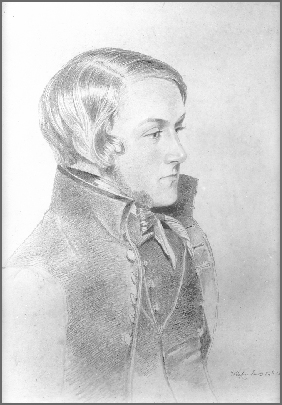
Peter Le Neve-Foster, M.A. (1809-1879), Secretary of the Society of Arts. From a pencil sketch made in 1834 by Elizabeth Rigby.
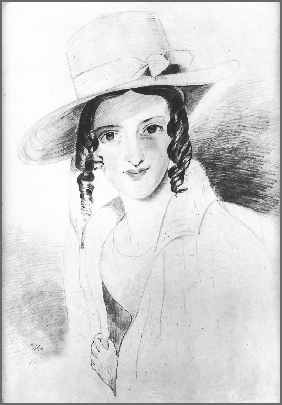
Georgiana Elizabeth (nee Chevallier) died 1885, wife of Peter Le Neve-Foster, M.A. Also from a sketch attibuted to Elizabeth Rigby in the Castle Museum, Norwich.
Peter and the Royal Society of Arts *
Mr. D. C. G. Allan, the Archivist and Curator-Librarian of the Royal Society of Arts, has given me the following account of Peter Le Neve-Foster's work for that remarkable and ancient Society:
The (Royal) Society of Arts is known today chiefly for its widespread system of external Examinations and for the special interest it takes in industrial design. At its commencement in the middle of the 18th century, its work was very different. Then it sought to guide the entire economic life of the nation through the distribution of medals and money prizes for "Inventions, Discoveries and Improvements" in Arts, Manufactures and Commerce. For half a century this method achieved great success but by 1837 when Peter Le Neve-Foster became a member, many competing organisations had been created and the Society had fallen into serious decline through shrunken funds and over ambitious aims. A reformation followed and in the 1840's when the constitution of the Society was established on the present-day basis of control by a governing Council, instead of the cumbersome imitation of parliamentary practice which had prevailed hitherto. Peter was among the first members of this newly formed Council to be appointed, as he had already served the government of the Society under the old constitution as Chairman of the Committee of Accounts. He was Honorary Treasurer from 1845 to 1852-an office, which was to be held by his great grandson a century later. The Secretaryship of the Society, which was a paid and permanent appointment, became vacant in 1853. Peter applied for the appointment and was interviewed with six other candidates at a meeting held on 11th June.
The following minutes have been preserved:
"The Council met this day at four o'clock. . . . The Council then proceeded to consider the applications of the several candidates for the Secretaryship, and carefully considered the letters and testimonials which had been received from them. . . the Council having fully discussed the qualifications of the respective candidates proceeded to ballot when the Chairman declared that Mr. Foster was unanimously selected."
*The Society was founded in 1745, incorporated in 1847 and was granted the title "Royal" in 1908.
For the next twenty-five years he was to discharge the duties of this office with energy and enthusiasm. Amongst the most onerous was the production of a weekly Journal which contained all the papers read to meetings of the Society as well as a miscellany of information about artistic and industrial developments at home and abroad. The Journal served not only the members of the Society of Arts but a nationwide "Union" of educational institutions. As Secretary, Peter was in correspondence with these institutions and assisted them in the arrangement of the educational conferences and exhibitions which marked the 1850's and 1860's.
Following the success of the Great Exhibition of 1851, the Society planned and to a large extent conducted the International Exhibition of 1862. Peter's Secretaryship also saw the Society active in a number of specific "causes", Patent Law amendment, postal reform and the prevention of food adulteration. It developed its special sections for specialised lectures "Indian", "African" and "Chemical" and, most significant of all perhaps, for the future, its examinations, which began in 1854, the year after Peter's appointment. To quote the words of his obituary in the Society's Journal of 28th February 1879:
"It would be impossible to particularise any portion of the Society's action with which he was more specially connected than with all the rest. It might almost be said that in every department of it he took an equal interest and, at any rate, to each one loyally devoted his powers and his time. How much of the success gained by the various movements of the Society was due to Mr. Foster can, indeed, never be known, for he was ever ready to do the work without seeking to obtain for himself the credit that was his due. His individual contributions to the Society's proceedings are to be found in every volume of the Journal."
The circumstances of his unexpected death "in harness" were related in the same document:
"Though Mr. Foster had attained a good age-he was in his seventieth year when he died-none of his many friends had any anticipation that he would not, for some time yet, be able to continue the work at which he had so long been engaged. Since Christmas last he had been confined a few days by an attack of gout, but it was hoped that the illness had left him, for he was apparently quite restored to health, and he was able to resume his duties at the Society, which had been for a short time interrupted. However, on Thursday, the 20th instant, shortly after his return to his own house at Wandsworth, he was seized with a sudden attack of syncope, the result of fatty degeneration of the heart. There were no serious symptoms of anything seriously wrong, till a member of his family coming into the room where he had been sitting by himself for a few minutes reading the newspaper, found that he had fallen back in his chair, dead. So little expected was the attack, that he had finished his ordinary day's work at the office, and had even walked up from the railway station to his own house about an hour before his death. During the day, none of the friends who saw him noticed any alteration in his manner or appearance, nor was there the slightest warning of his so sudden end."
His successor as Secretary, Sir Truman Wood, wrote in 1913 of Peter's achievement in maintaining the second era of prosperity of the Society. From the vantage point of the 1960's we may add that the present-day Royal Society of Arts derives much of its character from the Secretaryship of Peter Le Neve-Foster.
Peter was a knight of the Tunisian Order of Iftikar and a member of the Italian Order of the Redemption. The insignia of the Tunisian Order has survived and is preserved in my house at Borley, together with the two large decorative glass jars, one bearing the Imperial arms, which were presented to Peter by the Emperor Franz Josef of Austria.
Though he occupied so many public offices and was honoured by foreign countries, Peter never received a State Honour in his own country. This is all the more surprising as his two immediate successors at the Royal Society of Arts, Sir Henry Truman Wood and G. K. Menzies, received a knighthood and a C.B.E. respectively.
Apart from his large family and his work at the Society of Arts, Peter Le Neve-Foster's life seems to have been centred to a considerable extent on his hobby of photography and the following notes have been prepared by Mr. Arthur T. Gill, F.R.P.S., of the Royal Photographic Society.
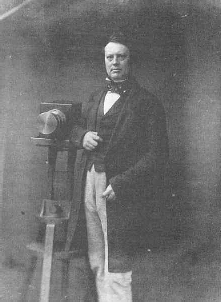
Peter Le Neve-Foster, the Photographer.
I start by quoting from the "Recollections" of Reginald Le Neve-Foster, one of Peter's sons and himself a keen photographer.
"My father was one of the first amateurs to practise photography, working the old paper process. . . "This relates to the Calotype or Talbotype process that Fox Talbot had patented in 1841. A piece of paper coated with potassium iodide was brushed with gallic acid and silver nitrate, placed in the camera either still moist or even dry, and exposed. I t was developed by a further application of gallic acid and silver nitrate and fixed, originally in potassium bromide, but later "hypo" was used. The resulting paper negative, sometimes waxed to make it more translucent, was printed by the older photogenic drawing process of 1839.
I am not sure when Peter first became involved in photography but he was a member of a group, founded in 1847 by Peter Fry, who joined interest in taking Calotype pictures. Roger Fenton, another barrister, who later was to take photographs of the Crimean War, was also in this group. There is an album of Peter Le Neve-Foster's Calotype photographs, made while he was a member of this group, still preserved at the Royal Society of Arts.
Fox Talbot had placed considerable restrictions on photography by insisting on patent rights for almost all processes which, he claimed, stemmed from his own. Peter was one of the committee of six which tried to persuade him to relent, but the conditions put up were unacceptable and it was only after a letter from the Presidents of the Royal Society and the Royal Academy that Fox Talbot gave way in the late summer of 1852. The Calotype group then set about organising a photographic exhibition, the first in the country. Again Peter was involved. It was opened on 22nd December 1852 and was quickly followed by a meeting called by Fenton to form a Photographic Society. Peter by now had been appointed Secretary of the Society of Arts, a position he was to hold until his death, and brought to the meeting a resolution from that body. The Photographic Society (later to become the Royal Photographic Society) was formed and Peter became one of the first members of its Council, a post he held for many years. He took an active part in its meetings, taking the chair on a number of occasions. His contributions to discussions on a wide variety of subjects show him to have been a knowledgeable and practical photographer. One gathers too, an impression of a kindly, tolerant man. He forsook the Calotype process for the Wet Collodion process introduced by Frederick Scott Archer in 1851. A camera he used for this process and a sensitising bath in which the collodion-coated plates were dipped just before exposure, are preserved in the Museum of Photography of the Royal Photographic Society.
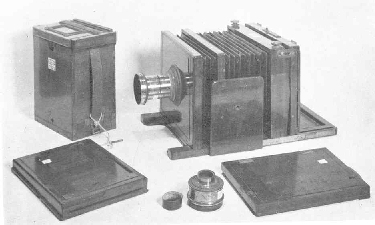
The Hare camera and accessories used by Peter Le Neve-Foster and now represented in the Royal Photographic Society's Museum. This camera dates from about 1866 and was in regular use until 1939.
The camera (see illustration) takes half-plate (6 ½ in. x 4 ¾ in.) pictures and many of the pictures in his album are of this size. It was made by G. Hare and is a "de luxe" type of their Universal Camera first advertised in 1866.
Peter Le Neve-Foster had two lenses he used it with; a Grubb landscape lens, shown with its lens cap in the foreground of the illustration, a simple achromatic lens of 8 ½ in. focus, its serial number 879 shows it to be quite an early lens. The other lens, shown mounted on the camera is a Voigtlander of the Rapid Rectilinear type. Its focus is 10 in. and it dates from after 1866, when this type of lens was introduced; it would give better definition and less distortion than the earlier lens. A slot in the barrel would take Waterhouse stops. The camera has both swing and tilt back so that architectural subjects would present vertical uprights. The extra extension forward from the side board is an unusual feature in Hare's "Universal" and was probably "made to measure".
In front of the illustration to the right is the dark slide provided with the camera. Inside, across the corners of the plate rebate, are silver wires on which the plate rested in its "wet" condition. It is not much stained with silver nitrate, so was not a great deal used. The changing box and special slide on the left were, possibly, bought at a later date than the camera, in the late 1870's. They were also made by Hare and were for use with dry plates. The changing box holds fifteen plates in an internal rack, the darkslide can be positioned over anyone of the plates and, with an elaborate system of light traps, the plate can be dropped into the dark slide. After exposure it can be returned to its proper slot. Although Dr. R. L. Maddox suggested silver bromide in gelatine in 1871, coated plates were not available until Swann introduced them in 1877. Possession of this apparatus before 1879 shows that even up to the last year of his life Peter's active interest in photography was maintained.
A further sign that he was a keen photographer to the end is his photograph of Cleopatra's needle being erected. This event took place in 1878, only a few months before he died. The interesting method of raising the obelisk horizontally between wooden trestles before lowering it on to its plinth is evident in the photograph.
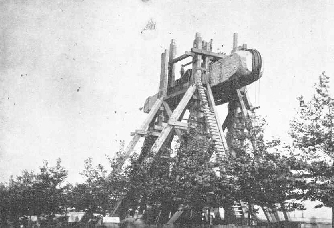
Cleopatra's Needle being erected on the Thames Embankment in 1878. This was one of the last, if not the last, photographs taken by Peter Le Neve-Foster before his death in 1879. The illustration is reporduced from a contact print made from the original negative by the late Basil Le Neve-Foster.
One wonders how this great interest in photography began. As already mentioned, it is known that Peter was on terms of friendship, in one case very close friendship, with a number of artists, including Love, J. B. Crome and Elizabeth Rigby in Norwich, and later with Sir Charles Eastlake, P.R.A. (Elizabeth Rigby's husband) in London. Peter was, himself, a competent pencil sketcher. Many of the very early photographers were artists who looked upon "sun pictures" as an extension of drawing. Perhaps it was as an amateur artist that Peter was first attracted to photography.